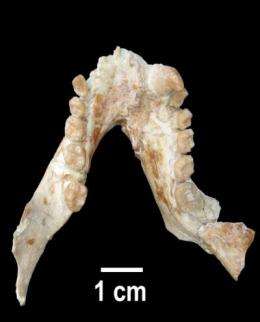Discovery of a primate more than 11 million years old

Catalan researchers have discovered in the rubbish dump of Can Mata in the Vallčs-Penedčs basin (Catalonia) a new species of Pliopithecus primate, considered an extinct family of primitive Catarrhini primates (or "Old World monkeys"). The fragments of jaw and molars found in this large site demonstrate that Pliopithecus canmatensis belongs to this group, which includes the first Catarrhini that dispersed from Africa to Eurasia.
Named Pliopithecus canmatensis, in honour of the place they were discovered in Catalonia, the new fossil species sheds light on the evolution of the superfamily of the Pliopithecoidea, primates that include various genera of basal Catarrhini, a group that diverged before the separation of the two current superfamilies of the group: the cercopithecoids (Old World monkeys) and the hominoids (anthromorphs and humans); and which prospered in Eurasia during the Early and Late Miocene (between 23.5 and 5.3 million years ago).
"Based on the anatomical, palaeobiographical and biostratigraphic information available, the most probable evolutionary scenario for this group is that the Pliopithecoidea were the first Catarrhini to disperse from Africa to Eurasia, where they experienced an evolutionary radiation in a continent initially deserted of other anthropoids (apes)", David Alba, main author of the study and researcher at the Catalan Institute for Palaeontology at the Autonomous University of Barcelona (UAB), explains to SINC.
The analysis of the dental pieces and the fragments of jaw discovered on the Catalan site has been published in the American Journal of Physical Anthropology.
According to the conclusions of the study, the new species belongs to the subfamily of the pliopithecines, which could have originated from an ancestor called the dionsisopithecine in Asia, from where they would have dispersed into Europe at the end of the Early Miocene (some 15 million years ago).
"On the Iberian Peninsula, the Pliopithecoidea have only been recorded in the Vallčs-Penedčs basin, where they are represented by pliopithecines and crouzelines", Alba confirms. During the Middle Miocene the crouzelines could have evolved locally in Europe from a pliopithecine ancestor, and dispersed into Asia afterwards, during the Late Miocene (some 10 million years ago). For the researchers, a greater knowledge of the palaeobiodiversity of the group will help to clarify the relationship between the three known subfamilies.
In search of clues
Another clue to clarify the relationships within this group is the recent discovery in China of a new genus and species of Pliopithecoidea, some 15 or 16 million years old and corresponding "probably" to a basal member of the crouzelines.
"This could indicate that the pliopithecines and crouzelines went to Asia before dispersing into Europe", points out the palaeontologist.
Although the relationship between the Pliopithecoidea and the rest of the Catarrhini is still not very clear, the former retain some very primitive characteristics. "However, in contrast to the Platyrrhini (New World monkeys), the Pliopithecoidea only present two premolars, meaning they can be considered as Catarrhini", Alba explains.
According to the new study, some characteristics derived from the dentition suggest that these animals are a 'clade' (monophyletic group) which, based on an African ancestor that migrated to Eurasia during the Early Miocene, was the first to radiate in this continent.
More information: Alba, David M.; Moya-Sola, Salvador; Malgosa, Assumpcio; Casanovas-Vilar, Isaac; Robles, Josep M.; Almecija, Sergio; Galindo, Jordi; Rotgers, Cheyenn; Berto Mengual, Juan Vicente. "A New Species of Pliopithecus Gervais, 1849 (Primates: Pliopithecidae) from the Middle Miocene (MN8) of Abocador de Can Mata (els Hostalets de Pierola, Catalonia, Spain)" American Journal of Physical Anthropology 141(1): 52-75, January 2010.
Provided by FECYT - Spanish Foundation for Science and Technology



















